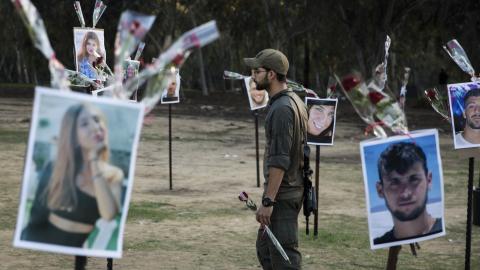Three Things about the Israel-Hamas War is a series from the Hudson Center for Peace and Security in the Middle East. Every week, Hudson Senior Fellows Michael Doran, Can Kasapoğlu, and Jonathan Schachter will join Research Fellow Zineb Riboua to offer an analysis of one thing—and one thing only—that is of particular importance to understand the Israel-Hamas war. Subscribe here.
Read their analysis below.
1. The Biden administration now publicly disagrees with the Israelis about three of the four most important aspects of the war in Gaza.
First, Washington and Jerusalem disagree over how long the war should last. When meeting with Israel’s war cabinet last week, Secretary of State Antony Blinken told Israeli Defense Minister Yoav Gallant that Israel did not have sufficient international support to fight for months. Israel must finish the job, Blinken said, in “weeks.”
Second, American officials openly express displeasure about Israeli tactics, which, they say, are causing excessive suffering among Palestinian civilians. “I made clear that before Israel resumes major military operations, it must put in place humanitarian, civilian protection plans that minimize further casualties of innocent Palestinians,” Blinken said while visiting Israel last week. “That means taking more effective steps to protect the lives of civilians, including by clearly and precisely designating areas and places in southern and central Gaza where they can be safe and out of the line of fire.”
Third, the two sides disagree about who should rule Gaza after the war ends. “Gaza and the West Bank should be reunited . . . under a revitalized Palestinian Authority,” President Joe Biden wrote in an op-ed on November 18. Vice President Kamala Harris, speaking at the United Nations climate conference in the United Arab Emirates on Saturday, repeated the president’s words. “The Palestinian Authority must be revitalized,” she said.
But Benjamin Netanyahu has different ideas. At a press conference on the same night as Vice President Harris’s remarks, he said that he was unwilling to delude himself into thinking that the Palestinian Authority, the very creation of which he termed a “terrible error,” could return to Gaza. Polling indicates that a large majority of Israelis agree with Netanyahu on this point.
The extent of Washington’s disagreement with Jerusalem makes one wonder whether the Biden team isn’t setting Netanyahu up to fail. But on one major point, Biden and Netanyahu do agree: Hamas must be defeated. And the Palestinian Authority cannot return unless Hamas is indeed destroyed.
Given the enormous public desire in Israel to see the war end in a clear victory, it is hard to imagine that the Biden administration will try to stop the fighting over disagreements on tactics and the duration of the conflict. Despite the growing American unease, therefore, this war will likely end in a clear Israeli victory over Hamas.
— Michael Doran
2. Biden’s Iran policy is facilitating the rise of the Houthis.
The Biden administration’s Iran policy is speeding the rise of the Houthis, turning Tehran’s Yemeni proxy into a bolder and better-protected version of Hezbollah that can threaten the Gulf, Israel, and maritime trade activity simultaneously. The Houthi network’s transition from making the diplomatic rounds to launching missile and drone salvos against Israel—and possibly against the United States Navy—marks a rising threat for the entire Middle East.
By early fall 2023, the Houthis seemed to be on the verge of reaching a peace deal with Saudi Arabia. But after the October 7 terror attacks on Israel, the group’s leadership opted instead to join a war over a thousand miles away from Yemen. This decision was no doubt guided by Iran’s Revolutionary Guard, in service of Tehran’s goal of making the battlefield’s contours as blurry and broad as possible.
The Houthis’ involvement comes as no surprise. Since the group’s first assault on Yemen’s capital Sana’a in 2014, it has widely utilized the slogan, “Death to America! Death to Israel!” The Houthis saw the October 7 attacks as a historic opportunity to jump into an unfolding war. Shortly after the attacks, the armed network’s leader, Abdul-Malek al-Houthi, delivered a radical speech that presaged his group’s entrance into the regional clash.
The Houthis are likely seeking to parlay their involvement in the conflict into increased popularity in Yemen, where no rival is likely to challenge them as they are fighting Israel in Gaza. Iran and its Yemeni proxy are looking for a political victory at the low cost of a few missiles.
Meanwhile, the Houthi-controlled regions of Yemen overlook a critical maritime choke point, the Bal el-Mandeb, which connects the Red Sea to the Gulf of Aden and the Arabian Sea beyond. Recently, the Houthis hijacked an Israeli-linked cargo ship plying a critical Red Sea shipping route. The militia’s involvement in the war is a threat to the maritime security of the region and to global trade.
Sadly, the Houthis’ rise was preventable. But the Obama administration’s appeasement of Iran in futile pursuit of the Joint Comprehensive Plan of Action (JCPOA) nuclear deal made it unwilling to punish Tehran’s proxy for its attacks on regional allies. The Biden administration has continued this soft approach, removing the group’s designation as a foreign terrorist organization and failing to punish its piracy and militancy. This appeasement has brought things to a dangerous state that is likely to further deteriorate.
— Can Kasapoglu
3. Secretary Blinken slips off the tightrope over Gaza.
Hamas is the primary beneficiary of the template for combat in Gaza it has developed over several rounds of fighting since 2008. The template follows a predictable dynamic:
1. Hamas targets civilians in Israel while hiding among and behind civilians in Gaza.
2. Israel responds by striking back at Hamas, and in the process unintentionally harms non-combatants in Gaza.
3. To limit those casualties, the United States and other countries pressure Israel to end the fighting, which leaves Hamas in place to lick its wounds, skim off the top of the international aid intended for Gaza’s reconstruction, and rebuild its arsenal for the next attack.
The unprecedented scope, scale, and savagery of the October 7 Hamas-led terrorist assault on Israel created an opportunity and the imperative to smash this template. President Biden and his administration continue to push Israel to minimize civilian casualties (which leaders in Jerusalem understand as consistent with both Israel’s values and its interests), but by rejecting calls for a ceasefire and endorsing Israel’s goal of destroying Hamas’s ability to threaten Israel and to govern Gaza, Biden has indicated that the rules have changed.
This is undoubtedly deeply disconcerting to Hamas, which continues to lose assets, personnel, and territory as the Israel Defense Forces drive forward. The unprecedented mix of Israeli military pressure and international support or tolerance for that pressure is likely the main reason Hamas was willing to release nearly half of the hostages it took into Gaza in exchange for a respite in the fighting last week.
Yet Secretary of State Blinken sent mixed messages to Israel and to Hamas while speaking in Tel Aviv Thursday. While expressing US support for Israel’s war aims, he also laid out a series of contradictory expectations regarding civilian casualties in renewed fighting. Making it sound like Israel was responsible for civilian casualties in Gaza instead of Hamas, he said that he had “underscored the imperative for the United States that the massive loss of civilian life and displacement of the scale that we saw in northern Gaza not be repeated in the south.” More dramatically, he reportedly told the Israeli war cabinet that Israel does not “have the credit” to destroy Hamas over several months.
Hamas’s leadership heard Blinken’s message loud and clear. His statements suggested its template for conflict may survive, incentivizing Hamas to renew the fighting, to put as many civilians as possible in harm’s way, and to prolong the conflict until Israel’s “credit” runs out. Less than 24 hours after Blinken’s remarks, Hamas broke the ceasefire and reneged on its commitment to return additional hostages.
— Jonathan Schachter

















